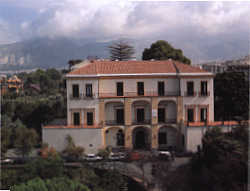







 |
The
Museum Correale, this valuable bulwark of Sorrento art and culture, has often
been defined "the most beautiful province museum of Italy". It is
situated in an ancient patrician villa, surrounded by a citrus grove that looks
onto the tuff ridge just in front of the Gulf of Naples. The villa and the
citrus grove, as well as the wonderful terrace of Belvedere, are part of a
donation to the town of Sorrento by the brothers Pompeo and Alfredo Correale,
the last descendants of the ancient patrician family. The family Correale was
native of Scala, an ancient town situated in front of Ravello and, from
historical data available in some documents as early as 1268, we know that they
were part of the "Sedile" (ancient nobles associations) of Porta in
Sorrento, of Portaretese in Salerno, of Porto in Naples. The brothers Correale
therefore put at Sorrento community’s disposal the villa belonged to their
family, for housing the art collections gathered in their numerous travels all
over Europe. The original character of patrician villa has been taken into
account in the arrangement of the numerous collections, disposed as if they
constituted the original furniture of the house.
 The Museum keeps one of the most beautiful collections of Neapolitan painters
dating from the seventeenth and eighteenth century, some works of the famous
"School of Posillipo" and by some masters of the Flemish and French
schools dating from the same period. It contains valuable Capodimonte and Sévres
ceramics, Murano glassware, Bohemia crystals and a collection of watches. The
archaeological collection is very interesting as well. A special mention
deserves the collection of Sorrento inlaid works dating from the nineteenth
century, that occupies the whole hall and is rich in tables, furnishings and
finely inlaid jewel cases. The poet and cabinet - maker Salvatore Gargiulo (Saltovar),
from Sorrento, donated many of these pieces to the Museum. The library,
containing various editions of works by Torquato Tasso and manuscripts of
different kinds, is very interesting as well. It keeps also Torquato Tasso’s
mortuary mask. The Museum keeps one of the most beautiful collections of Neapolitan painters
dating from the seventeenth and eighteenth century, some works of the famous
"School of Posillipo" and by some masters of the Flemish and French
schools dating from the same period. It contains valuable Capodimonte and Sévres
ceramics, Murano glassware, Bohemia crystals and a collection of watches. The
archaeological collection is very interesting as well. A special mention
deserves the collection of Sorrento inlaid works dating from the nineteenth
century, that occupies the whole hall and is rich in tables, furnishings and
finely inlaid jewel cases. The poet and cabinet - maker Salvatore Gargiulo (Saltovar),
from Sorrento, donated many of these pieces to the Museum. The library,
containing various editions of works by Torquato Tasso and manuscripts of
different kinds, is very interesting as well. It keeps also Torquato Tasso’s
mortuary mask.
 The Museum’s collections are arranged on three floors for a total of
twenty-four halls, to which has been added the garret recovered as an expository
room. The Museum’s collections are arranged on three floors for a total of
twenty-four halls, to which has been added the garret recovered as an expository
room.
Ground floor: Founders’ hall – Chapel Correale – Section Sorrento tarsia
dating from the nineteenth century – Archaeological Section – Romanesque
section.
First floor: Paintings and furniture dating back to the eighteenth century by B
Caracciolo, A. Vaccaro, Micco Spadaro, B. Corenzio, G. Lanfranco, P. De Matteis,
G. Dei Po, N.M. Rossi, E. De Mura, G. Bonito, C. Amalfi – Oriental chinaware
dating back to the seventeenth and eighteenth century – Hall of the Flemish
painters: P.P. Rubens, J. Vari Kassel, A. Grimmer, M. Sweerts.
Second floor: Still life paintings dating from the seventeenth and eighteenth
century by G.B. Ruoppolo, T. Realfonso, G. Cusati, A. Ascione, G. Casissa, A.
Belvedere – eighteenth and nineteenth century landscape - painters: J.R.
Volaire, S. Déms, G, Dughet, J. Rabbel, F. Vervloet. Landscape painters of the "School of Posillipo": A.S, Pitloo, T. Duelere, G. Gigante – Hall of
the Italian and European watches dating from the eighteenth century.
 Third floor: Italian and foreigner majolica dating from the centuries
seventeenth and eighteenth. Milano, Savona, Castelli, Sicily, Calabria,
Mausticres, Ruen. Italian and foreign chinaware dating from the eighteenth
century. Meissen, Wien, Ludwidsbourg, Nimphenburg, Zurich, Chelsa, Bow, S.
Petersbourg - Capodimonte, Doccia, Venice – Belvedere. Third floor: Italian and foreigner majolica dating from the centuries
seventeenth and eighteenth. Milano, Savona, Castelli, Sicily, Calabria,
Mausticres, Ruen. Italian and foreign chinaware dating from the eighteenth
century. Meissen, Wien, Ludwidsbourg, Nimphenburg, Zurich, Chelsa, Bow, S.
Petersbourg - Capodimonte, Doccia, Venice – Belvedere.
Via
Correale, 48 - Sorrento
tel. 081 878.18.46
Open everyday from 9.00 a. m. to 2.00 p. m., except Tuesdays and public holidays.
Admission: Euro 5,16
|
